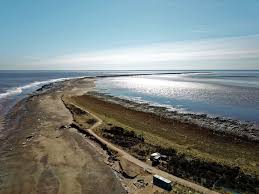Longshore Drift
"The Role of Longshore Drift in Coastal Erosion"
Longshore drift, also known as littoral drift or beach drift, is a fundamental coastal process that plays a crucial role in shaping the morphology of coastlines around the world. It involves the continuous movement of sand, sediments, and other materials along the shoreline due to the action of waves and currents. Here's a detailed description of longshore drift:

1. Wave Action: Longshore drift is primarily driven by the energy of ocean waves. As waves approach the shore, they carry a significant amount of sand and other sediments in suspension.
2. Oblique Approach: Most waves approach the shoreline at an angle, rather than directly perpendicular to it. This oblique angle is a key factor in the development of longshore drift.
3. Sediment Transport: When waves break, they release their energy and cause a net movement of water and sediments along the shore. The swash (movement of water up the beach) carries sediment onto the shore, while the backwash (water retreating back to the ocean) carries sediment back into the ocean. However, the swash is typically stronger than the backwash, resulting in a net movement of sediment in the direction of the wave approach.
4. Zigzag Movement: Over time, this net movement of sediment results in a zigzag or meandering pattern along the coastline. Sand and sediment are transported along the beach, creating features such as sandbars, spits, and barrier islands.
5. Coastal Landform Formation: Longshore drift is a key process in the formation of various coastal landforms, including beaches, barrier islands, and coastal dunes. It also contributes to the erosion and deposition of sediments along coastlines.
6. Coastal Erosion and Accretion: Depending on the local conditions and the direction of longshore drift, it can either lead to coastal erosion (removal of sediment from the shoreline) or coastal accretion (accumulation of sediment on the shoreline). Changes in longshore drift patterns can have significant effects on coastal communities and ecosystems.
7. Importance for Coastal Management: Understanding longshore drift is crucial for coastal management and engineering. It helps in designing effective strategies for mitigating erosion, maintaining navigational channels, and preserving coastal ecosystems.
In summary, longshore drift is a natural and dynamic process driven by wave action, which results in the continuous movement of sand and sediments along the shoreline. It is a vital component of coastal geomorphology and plays a significant role in shaping the coastal landscape and influencing coastal management decisions.
Longshore drift, also known as littoral drift or beach drift, is a fundamental coastal process that plays a crucial role in shaping the morphology of coastlines around the world. It involves the continuous movement of sand, sediments, and other materials along the shoreline due to the action of waves and currents. Here's a detailed description of longshore drift:

1. Wave Action: Longshore drift is primarily driven by the energy of ocean waves. As waves approach the shore, they carry a significant amount of sand and other sediments in suspension.
2. Oblique Approach: Most waves approach the shoreline at an angle, rather than directly perpendicular to it. This oblique angle is a key factor in the development of longshore drift.
3. Sediment Transport: When waves break, they release their energy and cause a net movement of water and sediments along the shore. The swash (movement of water up the beach) carries sediment onto the shore, while the backwash (water retreating back to the ocean) carries sediment back into the ocean. However, the swash is typically stronger than the backwash, resulting in a net movement of sediment in the direction of the wave approach.
4. Zigzag Movement: Over time, this net movement of sediment results in a zigzag or meandering pattern along the coastline. Sand and sediment are transported along the beach, creating features such as sandbars, spits, and barrier islands.
5. Coastal Landform Formation: Longshore drift is a key process in the formation of various coastal landforms, including beaches, barrier islands, and coastal dunes. It also contributes to the erosion and deposition of sediments along coastlines.
6. Coastal Erosion and Accretion: Depending on the local conditions and the direction of longshore drift, it can either lead to coastal erosion (removal of sediment from the shoreline) or coastal accretion (accumulation of sediment on the shoreline). Changes in longshore drift patterns can have significant effects on coastal communities and ecosystems.
7. Importance for Coastal Management: Understanding longshore drift is crucial for coastal management and engineering. It helps in designing effective strategies for mitigating erosion, maintaining navigational channels, and preserving coastal ecosystems.
In summary, longshore drift is a natural and dynamic process driven by wave action, which results in the continuous movement of sand and sediments along the shoreline. It is a vital component of coastal geomorphology and plays a significant role in shaping the coastal landscape and influencing coastal management decisions.
#LongshoreDrift
#CoastalErosion
#BeachProcesses
#SedimentTransport
#CoastalGeology
#ShorelineDynamics
#BeachManagement
#MarineGeology
#CoastalScience
#BeachEcology
#CoastalErosion
#BeachProcesses
#SedimentTransport
#CoastalGeology
#ShorelineDynamics
#BeachManagement
#MarineGeology
#CoastalScience
#BeachEcology



Comments
Post a Comment